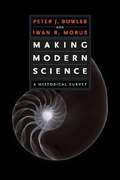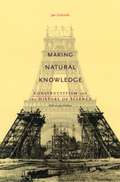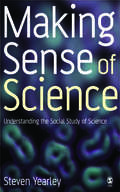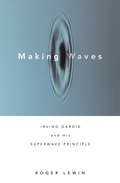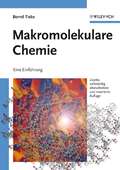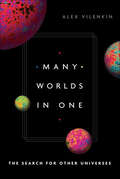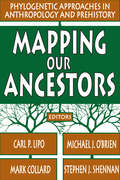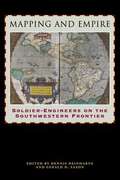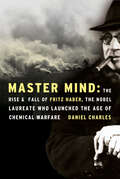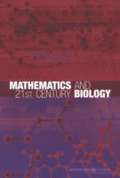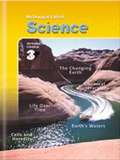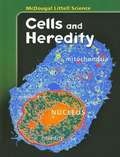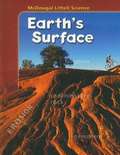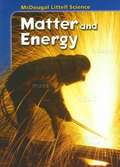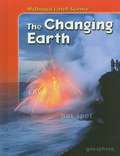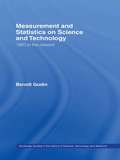- Table View
- List View
Magnets and Motors: Student Investigations
by National Science Resources CenterNIMAC-sourced textbook
Making Modern Science: A Historical Survey
by Peter J. Bowler Iwan R. MorusA textbook about the history of modern science with cross-references. The book is divided into two parts, one on episodes, the other on themes. It covers all major developments in scientific thinking--evolutionism, genetics, nuclear physics, and modern cosmology.
Making Natural Knowledge: Constructivism and the History of Science
by Jan GolinskiArguably the best available introduction to constructivism, a research paradigm that has dominated the history of science for the past forty years, Making Natural Knowledge reflects on the importance of this theory, tells the history of its rise to prominence, and traces its most important tensions. Viewing scientific knowledge as a product of human culture, Jan Golinski challenges the traditional trajectory of the history of science as steady and autonomous progress. In exploring topics such as the social identity of the scientist, the significance of places where science is practiced, and the roles played by language, instruments, and images, Making Natural Knowledge sheds new light on the relations between science and other cultural domains. "A standard introduction to historically minded scholars interested in the constructivist programme. In fact, it has been called the 'constructivist's bible' in many a conference corridor."—Matthew Eddy, British Journal for the History of Science
Making Sense of Science: Understanding the Social Study of Science
by Steven Yearley`Fluid, readable and accessible ... I found the overall quality of the book to be excellent. It provides an overview of major (and preceding) developments in the field of science studies. It examines landmark works, authors, concepts and approaches ... I will certainly use this book as one of the course texts' Eileen Crist, Associate Professor, Science & Technology in Society, Virginia Tech Science is at the heart of contemporary society and is therefore central to the social sciences. Yet science studies has often encountered resistance from social scientists. This book attempts to remedy this by giving the most extensive, thorough and best argued account of the field and explaining to social scientists why science matters to them. This is a landmark book that demystifies science studies and successfully bridges the divide between social theory and the sociology of science. Illustrated with relevant, illuminating examples, it provides the ideal guide to science studies and social theory.
Making Waves: Irving Dardik and His Superwave Principle
by Roger LewinThe biography of a medical maverick who is challenging scientific convention with his astounding approach to achieving and maintaining health.Dr. Irving Dardik's radical notions about how all matter moves in interconnected waves has drawn deep skepticism from physicists, and his early attempts to put his theory into practice in the field of health care got him banned from practicing medicine in the 1990s. But now, after a decade's worth of rigorous research that seems to support Dardik's SuperWave theory, scientists at such esteemed institutions as MIT, Harvard, and Stanford Research International are signing on with Dardik's team to probe the possibilities. For example, Dardik's unique approach to physical exercise, based on his Principle, has achieved some remarkable successes in reversing symptoms of chronic disease.Making Waves weaves together two fascinating stories: Dardik's personal progression from vascular surgeon to scientific iconoclast and pioneer, chronicling his struggle to convince the scientific community to take him seriously; and the evolution of his mind-expanding SuperWave Principle. Colleagues--skeptics as well as supporters--consider the impact of SuperWave theory on current thinking about nature on all scales, from the universe to the subatomic world, and in the realms of biology, applied science, and medicine. The resulting read will interest those concerned with their own health and vitality as well as those curious about the fundamental workings of nature.
Makromolekulare Chemie: Eine Einführung
by Bernd TiekeFür Chemiker, Polymerchemiker und besonders für Chemiestudenten ist die zweite Auflage des Tiekes wieder ein gelungenes und ausgewogenes Lehrbuch über das Basiswissen in der Makromolekularen Chemie. Mit der bereits bewährten Didaktik wird der Stoff der Makromolekularen Chemie in verständlicher Form und klar gegliedert dargestellt. Der Inhalt wurde verbessert, erweitert und aktualisiert. Neu behandelte Themen sind hierbei: lebende kationische und lebende radikalische Polymere, flüssigkristalline Polymere, elektrisch leitende Polymere, Polyelektrolyte, bioabbaubare Polymere und Verarbeitung und Recycling von Polymeren.
Manualito de imposturología física
by Fernando Vallejo"«El ser humano es una bestia bípeda entrenada durante cuatro millones de años de evolución (contados desde que bajó del árbol) para mentir de las formas más sutiles, de las cuales hoy por hoy las más prestigiosas son la palabra y las ecuaciones». Fernando Vallejo, que ya en otro libro de ensayos se había despachado de manera despiadada a Darwin, arremete en éste con igual rabia e inteligencia contra los que considera los máximos impostores de la ciencia, ahora del campo de la física. Este Manualito de imposturología física, además de plantear muy bien qué fue lo que trataron de entender estos «genios de la impostura» (Newton, Maxwell y Einstein, entre otros), explica por qué fracasaron en su intento. Aun para aquellos que nunca antes se hayan interesado por las teorías de Newton o las «marihuanadas» de Einstein, éste es un libro claro, instructivo y revelador. Una vez más Fernando Vallejo demuestra que la suya es una pluma ácida y lúcida, que no le teme a ningún tema ni a ninguna vaca sagrada."
Many Worlds in One: The Search for Other Universes
by Alex VilenkinA Leading Figure in the Development of the New Cosmology Explains What It All MeansAmong his peers, Alex Vilenkin is regarded as one of the most imaginative and creative cosmologists of our time. His contributions to our current understanding of the universe include a number of novel ideas, two of which—eternal cosmic inflation and the quantum creation of the universe from nothing—have provided a scientific foundation for the possible existence of multiple universes. With this book—his first for the general reader—Vilenkin joins another select group: the handful of first-rank scientists who are equally adept at explaining their work to nonspecialists. With engaging, well-paced storytelling, a droll sense of humor, and a generous sprinkling of helpful cartoons, he conjures up a bizarre and fascinating new worldview that—to paraphrase Niels Bohr—just might be crazy enough to be true.
Mapping Our Ancestors: Phylogenetic Approaches in Anthropology and Prehistory
by Stephen ShennanMuch of what we are comes from our ancestors. Through cultural and biological inheritance mechanisms, our genetic composition, instructions for constructing artifacts, the structure and content of languages, and rules for behavior are passed from parents to children and from individual to individual. Mapping Our Ancestors demonstrates how various genealogical or "phylogenetic" methods can be used both to answer questions about human history and to build evolutionary explanations for the shape of history.Anthropologists are increasingly turning to quantitative phylogenetic methods. These methods depend on the transmission of information regardless of mode and as such are applicable to many anthropological questions. In this way, phylogenetic approaches have the potential for building bridges among the various subdisciplines of anthropology; an exciting prospect indeed. The structure of Mapping Our Ancestors reflects the editors' goal of developing a common understanding of the methods and conditions under which ancestral relations can be derived in a range of data classes of interest to anthropologists. Specifically, this volume explores the degree to which patterns of ancestry can be determined from artifactual, genetic, linguistic, and behavioral data and how processes such as selection, transmission, and geography impact the results of phylogenetic analyses.Mapping Our Ancestors provides a solid demonstration of the potential of phylogenetic methods for studying the evolutionary history of human populations using a variety of data sources and thus helps explain how cultural material, language, and biology came to be as they are.
Mapping and Empire: Soldier-Engineers on the Southwestern Frontier
by Dennis Reinhartz Gerald D. SaxonFrom the sixteenth through the mid-nineteenth centuries, Spain, then Mexico, and finally the United States took ownership of the land from the Gulf Coast of Texas and Mexico to the Pacific Coast of Alta and Baja California—today's American Southwest. Each country faced the challenge of holding on to territory that was poorly known and sparsely settled, and each responded by sending out military mapping expeditions to set boundaries and chart topographical features.
Master Mind: The Rise & Fall of Fritz Haber, the Nobel Laureate Who Launched the Age of Chemical Warfare
by Daniel Charles“The dramatic life of a German Jewish scientist caught, of his own will, between the promise of science and the annihilation of war.” —Roald Hoffmann, chemist and writerFRITZ HABER—a Nobel laureate in chemistry, a friend of Albert Einstein, a German Jew and World War I hero—may be the most important scientist you have never heard of. The Haber-Bosch process, which he invented at the turn of the twentieth century, revolutionized agriculture by converting nitrogen to fertilizer in quantities massive enough to feed the world. The invention has become an essential pillar for life on earth; some two billion people on our planet could not survive without it. Yet this same process supplied the German military with explosives during World War I, and Haber orchestrated Germany’s use of an entirely new weapon—poison gas. Eventually, Haber’s efforts led to Zyklon B, the gas later used to kill millions—including Haber’s own relatives—in Nazi concentration camps.Master Mind is a thought-provoking biography of this controversial scientist, a modern Faust who personifies the paradox of science, its ability to create and to destroy. It offers a complete chronicle of his tumultuous and ultimately tragic life, from his childhood and rise to prominence in the heady days of the German Empire to his disgrace and exile at the hands of the Nazis; from early decades as the hero who eliminated the threat of starvation to his lingering legacy as a villain whose work led to the demise of millions.“A fascinating tale of science, history, politics, and antisemitism . . . exceptionally compelling reading.” —Deborah Lipstadt, author of Denying the Holocaust
Mathematics And 21st Century Biology
by National Research Council of the National AcademiesThe exponentially increasing amounts of biological data along with comparable advances in computing power are making possible the construction of quantitative, predictive biological systems models. This development could revolutionize those biology-based fields of science. To assist this transformation, the U.S. Department of Energy asked the National Research Council to recommend mathematical research activities to enable more effective use of the large amounts of existing genomic information and the structural and functional genomic information being created. The resulting study is a broad, scientifically based view of the opportunities lying at the mathematical science and biology interface. The book provides a review of past successes, an examination of opportunities at the various levels of biological systems— from molecules to ecosystems—an analysis of cross-cutting themes, and a set of recommendations to advance the mathematics-biology connection that are applicable to all agencies funding research in this area.
Matter: Science Reference Book
by Chicago Science GroupA science, student reference book covering: What Is Matter? Solids Liquids Gases Density Matter Changes States Mixtures Physical and Chemical Changes Tools of Science
McDougal Littell Science (North Carolina Edition, Grade Seven)
by The Editors at the McDougal LittellThis book is a comprehensive text on Middle school science with relevant topics like Cells and Heredity,Human Biology,Motion and Forces.
McDougal Littell Science Grade 8 (North Carolina Edition)
by Mcdougal LittelA science book that introduces the young future scientist to the systematic study of the nature from molecular particles to the human body to the whole universe. it's divided science into different fields: Life science Earth science Physical science
McDougal Littell Science Integrated Course 3
by The Editors at the McDougal LittellThe Changing Earth Chemical Interactions Life Over Time Cells and Heredity Earth’s Waters
McDougal Littell Science, Course 1: Integrated Course (Grade 6, North Carolina Edition)
by Rita Ann Calvo Kenneth Cutler James TrefilScience textbook for North Carolina 6th graders.
McDougal Littell Science: Cells and Heredity
by Rita Ann Calvo Kenneth Cutler James TrefilScientists are curious. Since ancient times, they have been asking and answering questions about the world around them. Scientists are also very suspicious of the answers they get. They carefully collect evidence and test their answers many times before accepting an idea as correct.
McDougal Littell Science: Earth’s Surface
by Mcdougal LittellScientists are curious. Since ancient times, they have been asking and answering questions about the world around them. Scientists are also very suspicious of the answers they get.
McDougal Littell Science: The Changing Earth (Grades 6-8)
by Mcdougal LittellIn this book you will see how scientific knowledge keeps growing and changing as scientists ask new questions and rethink what was known before. The text and pictures in this book will help you learn key concepts and important facts about earth science. A variety of activities will help you investigate these concepts.
McDougal Littell World Geography
by Marci Smith Deal Daniel D. Arreola James F. Petersen Rickie SandersThe earth is a unique planet capable of supporting a wide variety of life forms. Human beings adapt and alter the environments on earth.
Measurement and Statistics on Science and Technology: 1920 to the Present (Routledge Studies in the History of Science, Technology and Medicine)
by Benoît GodinHow do we objectively measure scientific activities? What proportion of economic activities should a society devote to research and development? How can public-sector and private-sector research best be directed to achieve social goals? Governments and researchers from industrial countries have been measuring science and technology for more than eighty years. This book provides the first comprehensive account of the attempts to measure science and technology activities in Western countries and the successes and shortcomings of statistical systems. Godin guides readers through the historical moments that led to the development of statistics on science and technology and also examines the socio-political dynamics behind social measurement. This enlightening account will be of interest to students and academics investigating science measurement as well as policy makers working in this burgeoning field.
Measures, Integrals and Martingales
by René L. SchillingThis is a concise and elementary introduction to contemporary measure and integration theory as it is needed in many parts of analysis and probability theory. Undergraduate calculus and an introductory course on rigorous analysis in R are the only essential prerequisites, making the text suitable for both lecture courses and for self-study. Numerous illustrations and exercises are included to consolidate what has already been learned and to discover variants and extensions to the main material. Hints and solutions can be found on the authors website, which can be reached at http://www.motapa.de/measures_integrals_and_martingales/index.html

